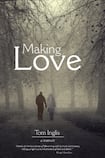
There is a manicured house in a village I pass through once a year. Its pristine condition draws the eye, as does the fact that its perfect exterior and gardens have always been extended or redecorated. I presumed the owners to be exceptionally houseproud until a local explained that they had lost a child in a car crash: their ongoing renovation would never be complete; it was their means of coming to terms with grief or keeping grief at bay.
There is no right or wrong way to come to terms with grief. Grief is a landscape without maps, where blind spots of emotional ambushes await, sparked by unexpected triggers. There are libraries of grief manuals that many find useful. For others they could be written in Japanese, because each person who enters there must find their own way out.
Tom Inglis, a sociology professor at University College Dublin, has chosen to map his experience of grief in this brave, often startlingly honest memoir. It deals with the death of his wife, the artist Aileen MacKeogh, from cancer in 2005, and with the entirety of their shared lives from meeting, as teenagers, at a dance in 1969.
Its opening chapters are superbly evocative, yet harrowing, as he brings us into the intensity of their desperate final days together, revealing her essence as a vibrant spirit fighting to savour every second of life, so immersed in the experience of living that almost until the end she refuses to accept the stark evidence that time has run out.
A born organiser, she coped with her terminal condition in three ways. First, by throwing herself headlong into mastering every fact about conventional and alternative treatments and endlessly listing results of blood tests. Second, by incorporating her illness into her art practice, making it part of her life by photographing her ailing body or surroundings. And, third, by refusing to allow disfiguring surgery, clinically induced baldness and wasted limbs to inhibit her femininity and innate sensuality. With all hope gone, and only days to live, she does not ask her husband to pray for some miracle; instead she asks him to lie beside her and, one last time, make love.
It is not easy for them to do so in death's shadow. But nor was it easy for them, for different reasons, when they were lovestruck teenagers with no private space or access to contraception, or much knowledge of sexuality beyond clues gleaned from the problem page of Jackie magazine.
Inglis’s title seems carefully chosen: during their 36 years together, lovemaking seemed central to their lives in its two meanings. In the physical sense it was almost an act of rebellion in the constrained middle-class south Dublin of cloying respectability they grew up in. But it was also central in the literal sense of making a loving shared space, shaping a relationship that survived the hammer blow of tragically losing a young son.
Inglis chronicles a life similar to many lived by Dubliners of their generation, though Aileen was always an initiator and breaker of conventions: the girl drinking whiskey in pubs where girls were meant to be absent or decoratively demure, the woman always creating new spaces ever since, as a teenager, she created a secret love nest on her father’s land.
Occasionally this reader felt an uneasy line being crossed between intimacy and voyeurism in some personal details about the author’s late wife. I see why they needed to be written; I am less sure why, in some final edit, they didn’t return to the cocoon of memory where no reader can go.
But the book is refreshingly honest in not being a manual about dealing with grief, in providing no answers to the heartache of how, when people truly love, they face the near certainty that one of them will be left to cope with the sense of feeling severed in two.
Inglis brings us into the intimacy of their marriage but places that marriage within the context of a changing society. He is superb on the emotional reticence of his father, who dies after suffering a stroke on a bus where the conductor, mistaking him for a drunk, leaves him sitting slumped against the window for several journeys into town.
It is a harrowing image: a man from a generation too inhibited to speak about their feelings, left staring out a bus window, unable to speak at all. Even if some readers may feel that Inglis says too much about his private life, this is better than being unable to say anything at all.
It should be mentioned that, in addition this very personalised memoir, sociology students will find much to interest them in Inglis's more academic exploration of grief, in his recent monograph, entitled Love (Routledge Shortcuts, €15.60). But more general readers interested in how Ireland changed during the latter half of the 20th century will be fascinated by how Inglis's memoir contextualises a deeply private life within a broader picture of Ireland, while always drawing us back to what Anthony Cronin described, in another context, as "a tiny republic of love".
Yeats queried whether a chestnut tree’s essence was “the leaf, the blossom or the bole”. Inglis’s achievement is to capture his lost wife’s essence in not just one version. There is the indelible ache of her absence, the terror, compassion and closeness of her final illness, but also captured here are all the Aileens who ever existed in a rich though sadly truncated life, stretching back to the 16-year-old Aileen with whom he fell in love.
Dermot Bolger is a novelist, playwright and poet










